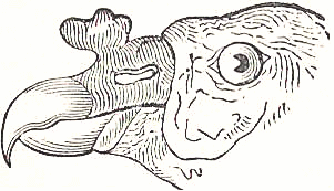
Condor picture
|
Contnued from The Andean Condor
The accounts given by early travellers of the Condor's
size and ferocity were so obviously exaggerated that the cautious Ray would
not admit it into Willughby's
Ornithology,
and only included it
in his own Synopsis Avium (page 11) after proof that such a bird
existed had reached him in the shape of one of its wing-quills brought
by Captain Strong to Sir Hans Sloane from the coast of Chili. Nearly a
century passed before European ornithologists saw a complete specimen.
This was a female which Captain Middleton brought from the Strait of Magllan
and deposited in the Leverian Museum, where an illustration of it was made
in 1791 by Shaw (Mus. Lev.
No. 1, page 4, pl.) Shortly after, a
second specimen, this time an adult male, found its way from the same quarter
to the same Museum, and a drawing was also made of it in 1793 by the same
author (op. cit.
No. 6, page 4, pl.). Both these specimens
later passed into the Museum of Vienna (Von Pelzeln, Ibis,
1873,
page 16).
The Condor was, however, little known on the European
continent, until in 1806 when Humboldt communicated his classical
Memoire
on
the bird to the French Institute, and as he was certainly the first
scientific man who had made its personal acquaintance in life, (As Broderip
well remarks Molina can hardly have seen the bird, which he, like Buffon,
took to be the same as the Lammergeier.), his account of it deserves the
attention with which it has met, and the voracity,stupidity, and tenacity
of life of this huge Vulture have through him been long known to the world.
Its habits were later more fully described by Darwin
in his Journal. Yet a good many years passed before examples became
at all common in European museums, and Temminck writing in 1823 (Rec.
d'Ois. livr. 23) was only able to refer to a single one at Paris, beside
the two originally received in England. Seven years afterwards he made
an artistic illustration of a male which was alive at Paris, and says there
was another in Holland. But at or about the same time the species was exhibited
in London (Bennett, Gard. and Menag. Zool. Soc.
ii. page 8), where
it even bred, although the only young bird that, after an incubation lasting
from 7th May to 30th June 1846, or 54 days, was hatched lived only for
six weeks (Broderip, Leaves from the Note-Book of a Naturalist, pages
14 to 16).
|





